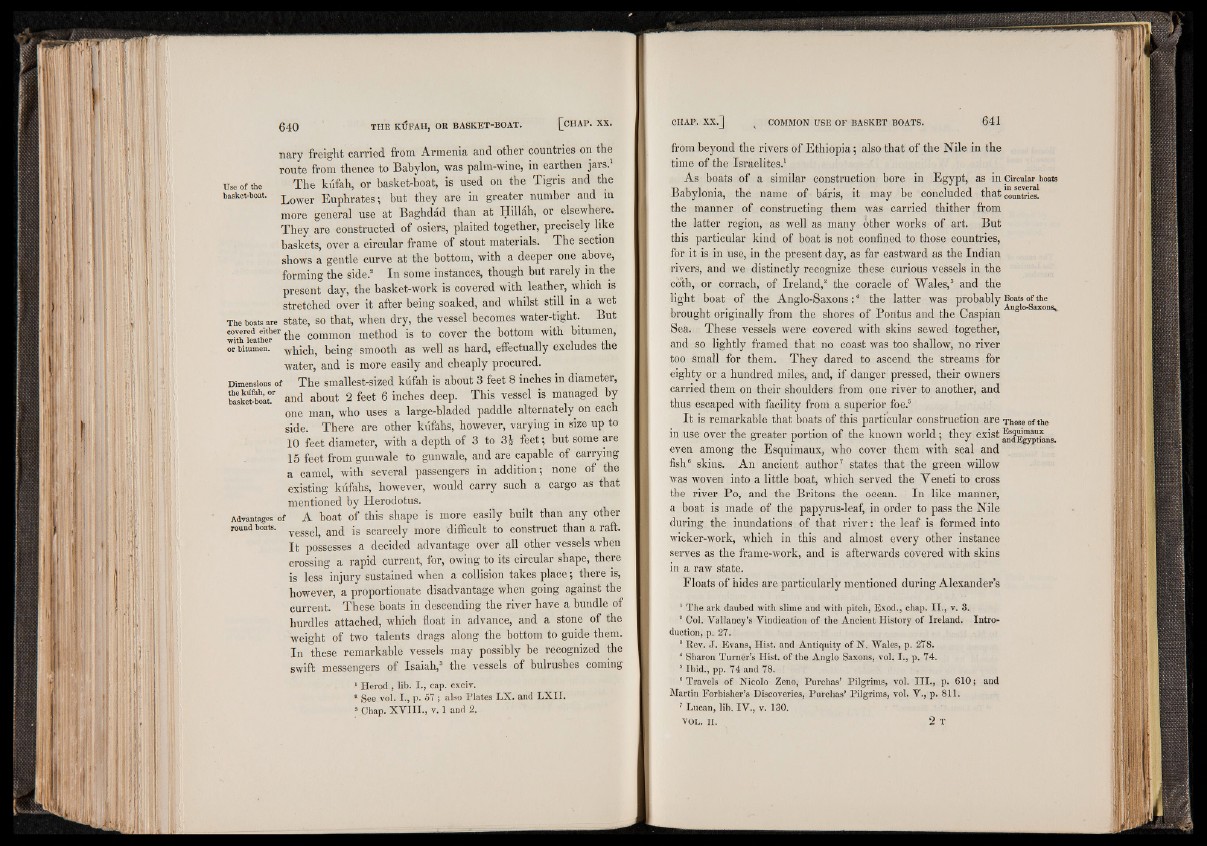
nary freight carried from Armenia and other countries on the
route from thence to Babylon, was palm-wine, in earthen jars.
Use Of the The kufah, or basket-boat, is used on the Tigris and the
basket-boat. Lower Euphrates; but they are in greater number and in
more general use at Baghdad than at Hillah, or elsewhere.
They are constructed of osiers, plaited together, precisely like
baskets, over a circular frame of stout materials. The section
shows a gentle curve at the bottom, with a deeper one above,
forming the side.2 In some instances, though but rarely in the
present day, the basket-work is covered with leather, which is
stretched over it after being soaked, and whilst still in a wet
The boats are state, so that, when dry, the vessel becomes water-tight. But
wUhrieitberer the common method is to cover the bottom with bitumen,
or bitumen, -which, being smooth as well as hard, effectually excludes the
water, and is more easily and cheaply procured.
Dimensions of The smallest-sized kufah is about 3 feet 8 inches in diameter,
basket-boat!' and about 2 feet 6 inches deep. This vessel is managed by
one man, who uses a large-bladed paddle alternately on each
side. There are other kufahs, however, varying in size up to
10 feet diameter, with a depth of 3 to 3£ feet; but some are
15 feet from gunwale to gunwale, and are capable of carrying
a camel, with several passengers in addition; none of the
existing kiifahs, however, would carry such a cargo as that
mentioned by Herodotus.
Advantages of A boat of this shape is more easily built than any other
round boats. veggep and js scarcely more difficult to construct than a raft.
It possesses a decided advantage over all other vessels when
crossing a rapid current, for, owing to its circular shape, there
is less injury sustained when a collision takes place; there is,
however, a proportionate disadvantage when going against the
current. These boats in descending the river have a bundle of
hurdles attached, which float in advance, and a stone of the
weight of two talents drags along the bottom to guide them.
In these remarkable vessels may possibly be recognized the
swift messengers of Isaiah,3 the vessels of bulrushes coming
1 Herod., lib. I ., cap. cxciv.
3 See vol. I., p. 57 ; also Plates LX. and L X II.
3 Chap. X V I I I ., v. 1 and 2.
from beyond the rivers of Ethiopia; also that of the Nile in the
time of the Israelites.1
As boats of a similar construction bore in Egypt, as in Circular boats
Babylonia, the name of baris, it may be concluded that countries,
the manner of constructing them was carried thither from
the latter region, as well as many other works of art. But
this particular kind of boat is not confined to those countries,
for it is in use, in the present day, as far eastward as the Indian
rivers, and we distinctly recognize these curious vessels in the
coth, or corrach, of Ireland,2 the coracle of Wales,3 and the
light boat of the Anglo-Saxons:4 the latter was probably Boats of the
brought originally from the shores of Pontus and the Caspian
Sea. These vessels were covered with skins sewed together,
and so lightly framed that no coast was too shallow, no river
too small for them. They dared to ascend the streams for
eighty or a hundred miles, and, if danger pressed, their owners
carried them on their shoulders from one river to another, and
thus escaped with facility from a superior foe.5
It is remarkable that boats of this particular construction are Those of the
in use over the greater portion of the known world; they exist ^ndEg^'tians
even among the Esquimaux, who cover them with seal and
fish6 skins. An ancient author7 states that the green willow
was woven into a little boat, which served the Yeneti to cross
the river Po, and the Britons the ocean. In like manner,
a boat is made of the papyrus-leaf, in order to pass the Nile
during the inundations of that river: the leaf is formed into
wicker-work, which in this and almost every other instance
serves as the frame-work, and is afterwards covered with skins
in a raw state.
Floats of hides are particularly mentioned during Alexander’s
1 The ark daubed with slime and with pitch, Exod., chap. I I ., v. 3.
3 Col. Valiancy’s Vindication of the Ancient History of Ireland. Introduction,
p. 27.
3 Rev. J . Evans, Hist, and Antiquity of N . Wales, p. 278.
4 Sharon Turner’s Hist, of the Anglo Saxons, vol. I., p. 74.
5 Ibid., pp. 74 and 78.
6 Travels of Nicolo Zeno, Purchas’ Pilgrims, vol. I I I ., p. 610; and
Martin Forbisher’s Discoveries, Purchas’ Pilgrims, vol. V., p. 811.
7 Lucan, l i b . IV ., v. 130.
VOL. II . 2 T